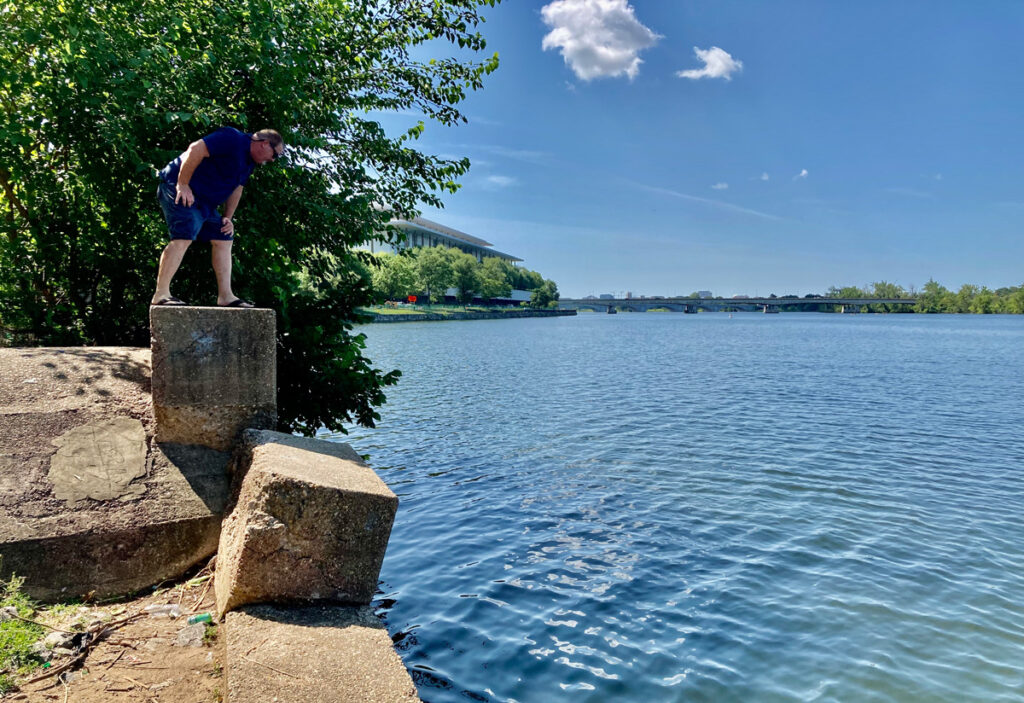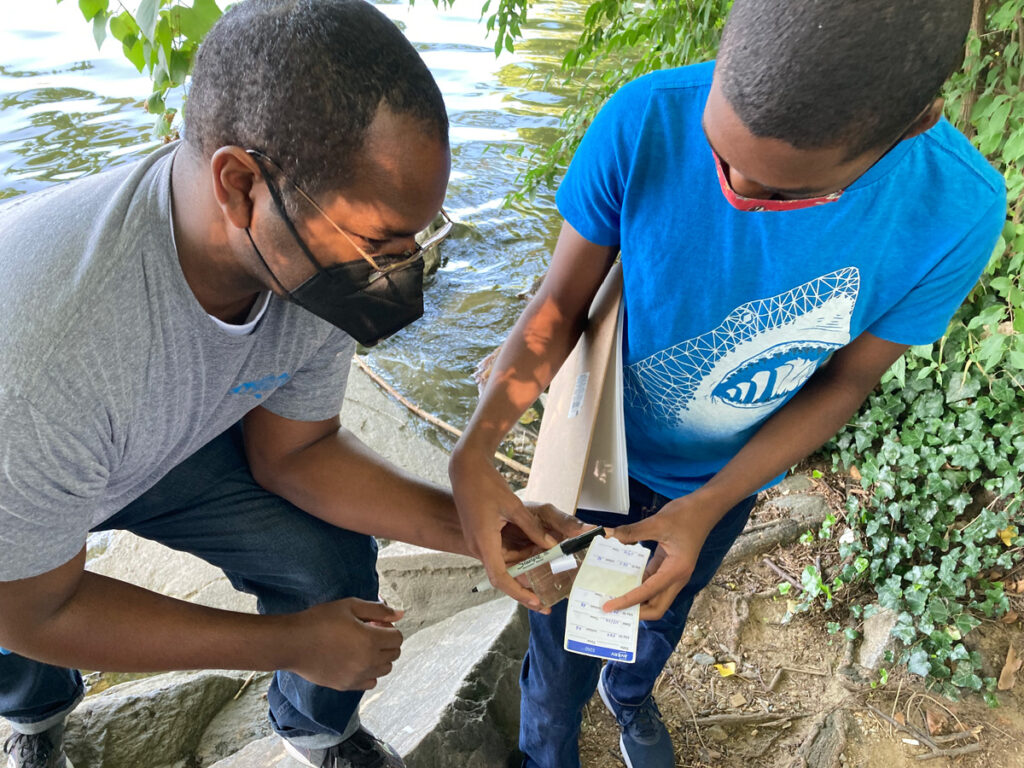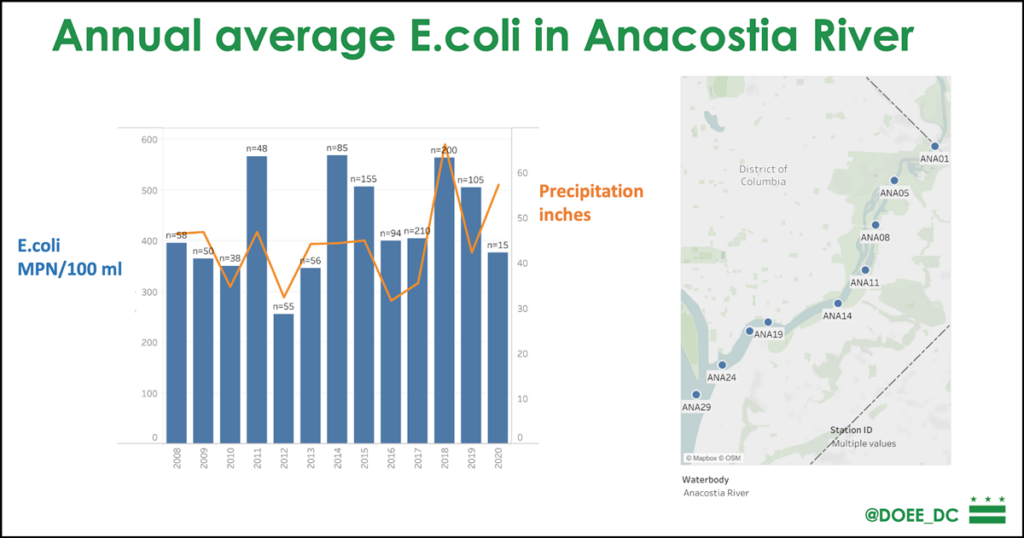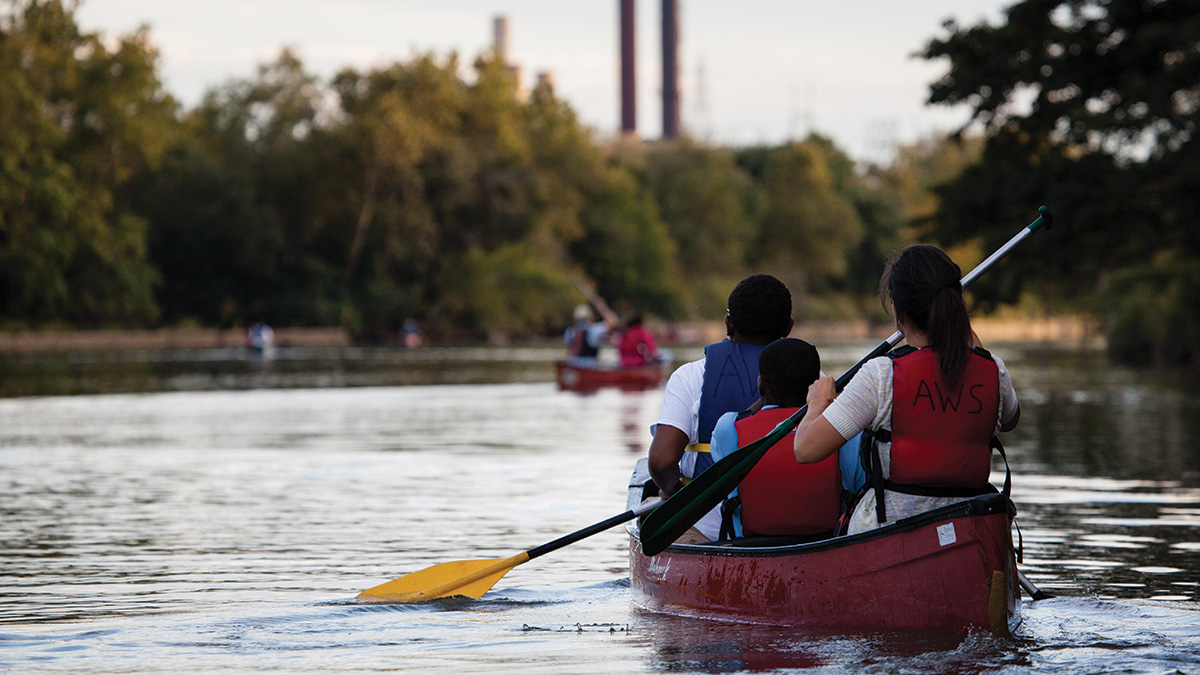In early September 2020, a freak storm dumped between 5 and 15 centimeters (2–6 inches) of rain in and around Washington, D.C., within 2 hours. My children had left a toy bucket in the yard of our home in Hyattsville, Md., just outside the city, and we watched it steadily fill to overflowing.
A few miles downstream, the sewer system of the nation’s capital was doing the same thing.
Like more than 800 other communities in the United States, much of the city relies on a combined sewer system built in the late 19th century. Unlike modern sewers that transport human waste and storm water to a treatment facility in separate pipes, a combined system mixes them together. With a large and sudden enough influx of storm water, the system hemorrhages sewage.
Some of the sewage flows backward, including into people’s homes. But most of it triggers a combined sewage overflow, or CSO, which means it jumps barriers and spills into the regular storm water system. From there, it has nowhere to go but downhill. In Washington, D.C., combined sewer outfalls line Rock Creek, the waterway nestled in the leafy park that winds along the capital’s spine. Dozens more outfalls empty into the Potomac and Anacostia rivers, which bracket the city like a riparian wishbone.

The Anacostia, flanked by some of the city’s least affluent neighborhoods, catches the brunt of those overflows. That day in 2020, D.C. dumped more than 680 million liters (180 million gallons) of raw sewage into the river according to the District of Columbia Water and Sewer Authority (DC Water).
It was not an isolated incident. Until a few years ago, the city saw an average of more than 180 CSOs that emptied 12.1 billion liters (3.2 billion gallons) of sewage into the rivers each year. That meant the waterways were more or less continually contaminated with high levels of fecal bacteria, traveling with their own nutrient-rich food source. Not only can a bacterial horde monopolize dissolved oxygen in a river ecosystem, killing off fish and anything else that breathes, but also it’s the main form of pollution that makes urban waters unsafe for human recreation.
But thanks to local activists who came to the rivers’ defense, the D.C. government is taking huge steps to curtail sewage overflows with the $2.7 billion Clean Rivers Project. Dozens of similar projects are underway in cities across the country, all with the goal of bringing their waterways into compliance with the Clean Water Act. It’s an expensive undertaking, but it could make many urban waterways safe enough to swim in.
Meanwhile, D.C.’s existing sewer system is reaching the end of its life span, and the changing climate is making events like the one in 2020 more frequent. As the Clean Rivers Project nears completion, government researchers and a small army of community scientists are building an understanding of how often—and maybe for how long—the city’s rivers will be swimmable.
An Old and Dirty Problem
At times, CSO events are like rancid flash floods, contaminating waters in spectacular fashion. Someone sent Dean Naujoks a video of such an overflow after a particularly intense summer thunderstorm a few years ago. Naujoks holds the position of Potomac riverkeeper with the Potomac Riverkeeper Network. “This thing shot sewage-laden storm water almost all the way across the river,” he said. “I wouldn’t have believed it unless I saw it.”
Sewage is full of bacteria from the collective intestines of the human population. Most of them are harmless, but some pathogens can cause serious illness. Naujoks knows firsthand the danger posed by CSOs. Once, while helping a woman out of her kayak near one of the outfalls, his toe slipped into the Potomac. The toe had a cut on it, and days later his entire foot was infected.

In 1972, the Clean Water Act required that most waterways be made safe for recreation by 1983 and that no pollutants, including sewage, be discharged into any navigable waters by 1985. Nearly 50 years later, it’s not clear how many waterways meet those goals. Each state is responsible for setting its own water quality standards, and states report the status of their waters to the federal government in different years. What is clear is that many urban areas, with the largest concentration of potential water users, do not yet have swimmable rivers.
Washington, D.C., has yet to comply with its own water quality standards, and its fix has been simply to ban swimming in its waterways except for permitted events, although Naujoks sees thousands of people flout the ban every summer. “There are so many undiagnosed ear and nose infections” associated with this behavior, he said. “[People] don’t even think about it.”
For the past decade, the city’s Clean Rivers Project has been creeping toward a solution to its CSO problem a few meters of rock at a time, drilling massive “deep tunnels” (so called because they’re placed underneath existing infrastructure) that are designed to temporarily store excess sewage during heavy rain events.
Birth of the Clean Rivers Project
Like so many environmental cleanup efforts, the Clean Rivers Project was the result of a lawsuit. In 2000, the Anacostia Watershed Society, along with several other organizations and a concerned citizen, sued the city over its practice of dumping combined sewage into its rivers. The U.S. EPA later joined the lawsuit as a plaintiff, citing the city’s violation of the Clean Water Act.
With a grant from the EPA, the Anacostia Watershed Society had begun to monitor the river for bacteria and share the results with the public. The numbers were dire—Jim Connolly, who led the organization at the time and now sits on its board, said that the river rarely met EPA boating standards and never met swimming standards. “Those data were very helpful” in bolstering their case in the lawsuit, he said, “and the fact that it was an EPA-funded grant gave us a lot more credibility.”
The city settled in 2005, signing a consent decree with the federal government that outlined an ambitious project to curtail combined sewage overflows. More than 130 other cities, including Atlanta, Baltimore, and Chicago, have signed similar agreements.
The city’s goal was to avoid 80% of the sewage overflow into the Anacostia River. Now that they’re operational, the tunnels are capturing 90%, along with 6,260 metric tons of trash and debris.
DC Water is now on the threshold of meeting the conditions of the consent decree. The first of several cavernous tunnels, each more than 30 meters (100 feet) under the city and large enough to accommodate one of its Metro trains, went into service in 2018. Carlton Ray, vice president of the Clean Rivers Project for DC Water, said the city’s goal was to avoid 80% of the sewage overflow into the Anacostia with the initial phase of the project. Now that they’re operational, the tunnels are capturing 90%, along with 6,260 metric tons of trash and debris to date.
“We’re doing a heck of a job so far,” said Ray, adding that the existing tunnels prevent CSOs only on the Anacostia. “But stay tuned. We’re on track to get the rest of them.”
The Anacostia phase will be completed by 2023. The final section of the project, on the Potomac side, is slated to come online in 2030. By then, Ray said, 96% of the city’s sewage overflow problem will be contained.
In light of that progress, many Washingtonians are hopeful the city may soon lift its decades-old swim ban. Urban planners have gone so far as to draw up plans for public swimming platforms on the Anacostia. And the monitoring data that helped force the city to act are now going straight to the people.
Crowdsourced Science Steps Up
In 2018, D.C.’s Department of Energy and Environment (DOEE) awarded a 3-year grant to the nonprofit Anacostia Riverkeeper to bulk up its monitoring program. The organization is a member of the international Waterkeeper Alliance, a network of advocacy organizations that assigns a “keeper” to each waterway. Anacostia Riverkeeper partnered with other D.C. organizations, including Naujoks’s Potomac Riverkeeper Network, which then carried on its own monitoring program.

“The water quality has been pretty bad for ages,” said Adrian Bostic, who volunteers with his teenage son taking water samples for the Potomac Riverkeeper Network. They live in Northeast Washington, near the banks of the Anacostia, and joined the effort as a down payment on future afternoons fishing close to home. “[We] might as well get involved and do what we can do to help clean it up. And maybe we can get to actually experience the water that’s around us,” Bostic said.
Dozens of volunteers like the Bostics are out every week during the summer, collecting samples and rushing them to the lab for analysis while the bacteria in them are still fresh.
The Potomac Riverkeeper Network has its own lab aboard a repurposed fishing vessel. There, volunteers feed the collected bacteria a nutrient that causes them to change color—Escherichia coli glows under ultraviolet light. By dividing the water into rows of plastic bubbles, they can extrapolate the concentration of E. coli in the river by simply counting how many bubbles glow.

Later, volunteers upload the data to Chesapeake Monitoring Cooperative, where they’re made publicly available to both the community and researchers. The data will also be shared with Swim Guide, a crowdsourced global network that lets users look up whether their waterway is safe for recreation. According to Naujoks, about 25,000 people in the D.C. area used the site last year.
Samples are collected on Wednesdays, so the results are ready by the weekend. That’s when the largest crowds come out to kayak, fish, and—despite the law—swim.
Jeff Seltzer, a deputy director at DOEE, said the monitoring program is meant to warn residents when the water is especially unsafe, while also being a cost-effective way to shore up the city’s understanding of bacteria in its waterways. “It builds constituency and educates the public about the issues around water quality, and leverages that interest to get us more data,” he said.
“We’re not going to capture the whole picture with our efforts, but we are going to capture more than we know right now.”
To that end, D.C. has also partnered with the U.S. Geological Survey (USGS) on a new study that will lend scientifically reviewed methodology to future water quality alerts. Instrument stations at either end of the Anacostia will measure the water’s temperature, specific conductivity, pH, dissolved oxygen, and turbidity. An automated in situ analyzer will allow the stations to determine bacterial loads without the need to send samples to a lab.
With continuous high-quality data, said principal investigator Jonathan Dillow, the USGS project aims to find the connections between water conditions and bacterial loads in the river. Warmer and more turbid water, for instance, is more hospitable to bacteria. But how these factors interact within the complicated flow of the Anacostia—the river is partially tidal, which means that Chesapeake Bay water periodically flushes upstream, both slowing and churning it—determines whether bacteria persist in some parts of the river and die off quickly in others. All of this matters when trying to determine the true impact of combined sewer overflows on the river’s water quality.
“As far as I know, no one has successfully gone after the causality that might be reflected in the data that [have] been collected,” said Dillow. “We’re not going to capture the whole picture with our efforts, but we are going to capture more than we know right now.”
The goal of the USGS project is to build a model that can forecast whether the river will be safe for recreation on a continuous basis. Anacostia Riverkeeper is collaborating with a company called DataRobot on a similar bacteria forecasting model using machine learning. The organization is feeding the model data from its volunteer programs and from the government’s historical monitoring database.
The glut of new data, once readily available, could drive water quality policy across the region and allow local governments to concentrate their resources on the biggest problem areas.
Crumbling Infrastructure
Combined sewer overflows are not the only sources of bacteria in D.C.’s waterways. Two thirds of the city’s sewer system has separate pipes for sewage and storm water, but in addition to surface runoff sources like pet and wild animal waste, bacteria can end up in the rivers through residential sewer lines that are illegally connected to the storm drain system. (The city is working on a project that uses DNA fingerprinting to identify whether bacteria found in the river come from human waste, which will allow the municipal government to identify and target illegal connections.)
And aging sewer pipes can break or leak. In a recent report, the American Society of Civil Engineers (ASCE) estimated that the city’s average sewer main is more than 90 years old. Ray said DC Water’s goal is to replace its aging sewer infrastructure at a rate of roughly 1% per year, although ASCE noted that the city is not yet meeting that goal and in fact needs to double it.
Bacteria are also coming from upstream. While communities in the Anacostia’s upper watershed use separate sewer and storm drain systems, sewage can still make its way into the river’s many tributaries. Erosion, sped by development, has exposed buried sewer lines, making them more likely to be damaged by hazards like falling trees.
“It’s not just the DC Water project that is bearing fruit right now.”
During the September 2020 storm, the Northwest Branch Anacostia River, which flows past my neighborhood in Hyattsville, jumped its banks and invaded the little woods where I walk with my children. That night, there was so much sewage in the floodwater coming from upstream that my nostrils burned.
Anacostia Riverkeeper is expanding its monitoring program upstream to better understand all the contributors to the river’s bacterial load. “As we start looking [in] more places, we keep finding more spots” where sewage is entering the watershed, said Anacostia riverkeeper Trey Sherard.
As part of a consent decree similar to the one that led to the Clean Rivers Project, WSSC Water, the sewer authority in the Maryland counties that make up more than 80% of the Anacostia watershed, has been gradually repairing, upgrading, or replacing its pipeline system.
“It’s not just the DC Water project that is bearing fruit right now,” said Sherard. “Across all 176 square miles of [watershed], almost that entire area is seeing significant sewer infrastructure improvement.”
A Moving Target
But uncertainty looms over local optimism about swimmable rivers.
The year D.C. partnered with local organizations to do more frequent sampling of the rivers—the same year the first Clean Rivers tunnels came online—was also the wettest year on record in the District of Columbia. More than 167 centimeters (66 inches) of rain fell in 2018, 66 centimeters (26 inches) more than average. The city’s operational deep tunnels captured 17 billion liters (4.5 billion gallons) of combined sewage overflow. But it wasn’t enough.
“Even though you’re keeping out billions of gallons [of sewage], with the biggest rainfall events in history, you’re still getting significant input from the combined sewer system and other sources throughout the watershed,” said Seltzer.
“By the time they get built, according to today’s standards, they could be undersized.”
And the deluges keep coming. During the September 2020 storm, rain came down so hard and fast that the tunnels—with a combined capacity of more than 378 million liters (100 million gallons)—overflowed in just over half an hour.
The U.S. Global Change Research Program has projected that heavy rain events in the Northeast and Midwest will become more intense and more frequent by the end of the century. The heaviest 1% of events could produce at least 40% more precipitation. Nature is going to be hurling increasingly massive amounts of water onto cities with combined sewer systems, and keeping sewage out of waterways is going to get harder.
Darren Olson, vice chair of ASCE’s Committee on America’s Infrastructure, pointed out that many sewage overflow tunnel systems were designed in the 1970s and 1980s—quite a way back on the climate hockey stick. “What we’re finding with a lot of these systems that were planned decades ago [is that] by the time they get built, according to today’s standards, they could be undersized,” Olson said.
“We’re Trying to Make Sure That We’re Thinking This Out”
Milwaukee may be a bellwether. Its deep tunnel system was completed in 1993 and has been expanded twice. The system has had a huge impact on CSOs, cutting the number of overflow events from more than 50 per year to only two or three. But Milwaukee riverkeeper Cheryl Nenn said that 2018 and 2019 broke rainfall records in the city. It’s too early to tell exactly what effect that’s having on water quality, but there has been a recent uptick in the volume of sewage overflowing into Milwaukee’s rivers. “That was a real eye-opener here,” Nenn said. “We had not seen numbers like that in quite a while.”
The key to keeping up with ever increasing precipitation is to transform the urban
surface itself.
The key to keeping up with ever increasing precipitation, Olson said, is to transform the urban surface itself. Rain gardens, bioswales, and other measures to encourage water infiltration can take the pressure off deep tunnels by capturing rain where it falls, rather than funneling it into the combined sewer system in the first place.
D.C. is already undertaking some of those green infrastructure projects, and Ray said the tunnel system was designed to be expanded, including room for more pumps and treatment facilities to process sewage more quickly. “We’re trying to make sure that we’re thinking this out,” he said. “Not just 20 years out—a hundred years out.”
Even with such measures, said Olson, some coastal cities could see their sewer systems overwhelmed not by rain but by storm surges. “When you’ve got your sea level rising and all your storm sewers are draining out into that same body that’s rising, these storm sewers become even less effective at carrying water,” he said. Even upriver cities like D.C. are vulnerable to rising sea levels and tidal flooding. And once combined sewer systems start taking on seawater, no storage tunnel will be big enough to contain the overflow.
For now, D.C.’s main problem is rain, and more is on the way. The storage capacity of the Clean Rivers tunnels was based on rainfall data from 1988 to 1990; the picture those data painted is sure to shift. “If those historic rainfalls are increasing dramatically, as we predict they will,” said Seltzer, “then we’ll likely get more overflows than we had planned on.”
That’s where the community monitoring programs the city is sponsoring could become even more essential, especially if the city lifts its swimming ban. “We’ll have more days where we would just simply have to put out warnings and restrict swimming,” said Seltzer.
Naujoks, the Potomac riverkeeper, hopes D.C.’s system is big enough to handle what’s coming. Next year is the fiftieth anniversary of the Clean Water Act, and he wants the city to understand that even 50 years from now, the law’s goal of giving Americans back their waterways will not have changed. He plans to make sure that the Clean Water Act is honored in the nation’s capital.
“There’s constant vigilance,” he said. “That’s the role of a water keeper.”
Author Information
Mark Betancourt (@markbetancourt), Science Writer


